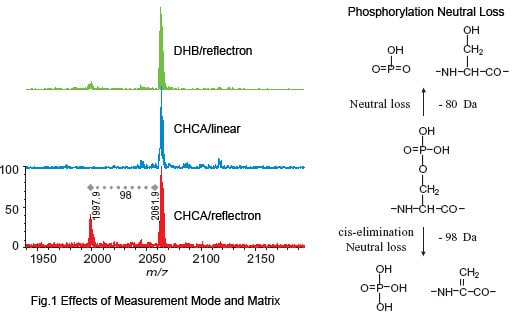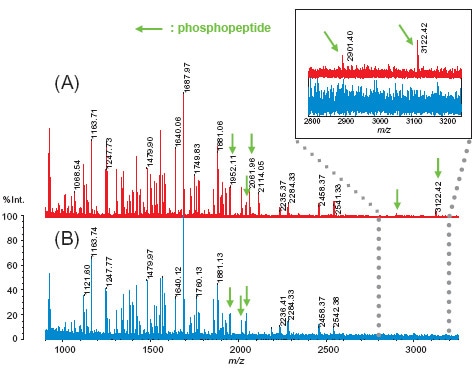Post-Translational Modification Analysis | Phosphorylation Analysis by MALDI-TOF MS (1)
Post-Translational Modification Analysis
Phosphorylation Analysis by MALDI-TOF MS (1)
■ Selecting the Ideal Measurement Mode and Matrix for Phosphopeptide Detection
Phosphorylation is one type of post-translational modification of proteins. It plays an important function in organisms.
The analysis of phosphopeptides using MALDI detection is introduced below.
To achieve higher resolution and accuracy, the reflectron mode is used for normal peptide measurements. However in this mode, signals from the target phosphopeptides are difficult to detect due to the so-called neutral loss phenomenon, whereby the phosphate group is dissociated from the phosphopeptide. Therefore, such unstable compounds are first measured in the linear mode.
As shown in Fig. 1, only the signal corresponding to the phosphopeptide is observed in the linear mode. By using DHB as the matrix, a spectrum can also be obtained in the reflectron mode with the neutral loss comparatively suppressed.
Conversely, neutral loss can also be used to evaluate the absence or presence of phosphorylation. If neutral loss is discovered in comparisons between the reflectron mode and linear mode and between DHB and CHCA, there is a high probability that the peptide is phosphorylated.

Another problem with the analysis of phosphopeptides is the significant decrease in peptide detection sensitivity due to phosphorylation modification. Consequently, it is often difficult to observe phosphopeptides in protein enzyme digests.
Methods of overcoming this problem include adding phosphoric acid to the matrix, and increasing the concentration of trifluoroacetic acid (TFA) to maintain the acidity.
Fig. 2 shows the effect of adding phosphoric acid when using DHB as the matrix. A mixture of four digested proteins was analyzed in the reflectron mode.
When measured using DHB only, phosphopeptides contained in large quantities can be observed but phosphopeptides contained in small quantities are almost impossible to observe. However the phosphopeptide near m/z 3000 could be observed when phosphoric acid was added to the matrix.

Fig. 2 Addition of Phosphoric Acid: (A) Phosphoric Acid Added (0.5 %), (B) No Phosphoric Acid Added
Consequently, changing the measurement mode or matrix composition enhances the detection sensitivity for phosphopeptides in the sample mixture. Such basic steps are used for structural analysis such as MS/MS.
AXIMA Performance MALDI-TOF MS

The AXIMA Performance is one of the most powerful tools in mass spectrometry, delivering information-rich spectra with greater sensitivity and higher confidence in identification. It is an extremely versatile and powerful TOF-TOF system, integrating workflows for a diverse range of analytical needs.
- From high energy MS/MS of proteomics and other biological and organic samples to uncompromised analysis of high mass intact proteins
- True high energy MS/MS - CID with a laboratory frame collision energy of 20keV
- Optimal precursor ion selection resolution using revolutionary gating technology
- Outstanding sensitivity - uncompromised design, to ensure no MS/MS signal is discarded


